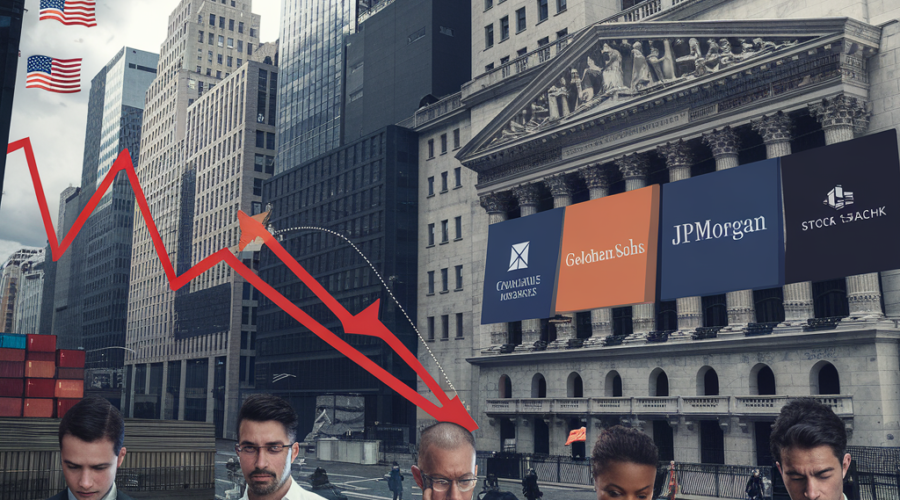The once-booming dealmaking environment that fueled Wall Street’s post-pandemic recovery has ground to a halt as President Donald Trump’s escalating trade war creates unprecedented market uncertainty. Major financial institutions including JPMorgan Chase, Goldman Sachs, and Bank of America are preparing for significant workforce reductions amid a 15% year-over-year decline in global M&A volume and a 40% drop in U.S. IPO filings through Q1 2025[3][6][8]. This strategic retrenchment marks a dramatic reversal from the 24% increase in investment banking fees Wall Street firms recorded in 2024, when markets anticipated Trump’s second-term policies would unleash corporate expansion[3][8].
The Tariff Shockwave: From Market Euphoria to Dealmaking Deep Freeze
Policy Whiplash Undermines Strategic Planning
Wall Street’s current crisis stems from the accelerating pace of protectionist measures, with the Trump administration implementing 34% tariffs on $550 billion of Chinese imports and 50% duties on Canadian steel exports since March 2025[1][7][8]. This policy barrage has created what Goldman Sachs analysts describe as “the most volatile trade policy environment since the Smoot-Hawley era,” with the VIX fear index averaging 38.6 in March compared to 18.2 during the same period last year[4][5]. The S&P 500’s 14.7% decline since February’s peak has erased $9.3 trillion in market capitalization, leaving corporate boards hesitant to pursue transformative deals[4][7].
Deal Pipeline Evaporation
The collapse in transaction activity appears systemic across all major sectors. Technology M&A volume plummeted 62% year-over-year to $48 billion in Q1, while energy sector deals fell 54% to $29 billion[3][6]. Private equity exits have been particularly hard hit, with sponsor-to-sponsor transactions declining 73% as valuation gaps between buyers and sellers exceed 30% in most industries[3]. “We’re seeing deals die in the due diligence phase when tariff exposure analysis comes in,” noted a Bank of America M&A director who requested anonymity[3].
Banking Sector Contagion: From Revenue Shortfalls to Workforce Restructuring
Revenue Projections in Freefall
Major institutions have slashed 2025 investment banking revenue forecasts by 18-25% since January, with JPMorgan reducing its global M&A fee pool estimate from $89 billion to $67 billion and Goldman Sachs cutting equity underwriting projections by 30%[3][5]. The damage extends beyond bulge bracket firms – boutique advisor Evercore’s stock has plunged 22% year-to-date, while Jefferies Financial reported a 19% decline in advisory revenue during its fiscal Q1[2][3].
Workforce Optimization Strategies
Faced with shrinking revenue pools, banks are implementing aggressive cost-cutting measures. UBS has instructed senior bankers to identify 15-20% of teams for potential reduction, while Morgan Stanley plans to trim 7% of its investment banking staff by Q3[3][6]. The cuts follow patterns from previous downturns, with junior analysts and sector specialists in vulnerable industries like automotive and consumer goods facing highest termination risks[2][3]. Bank of America’s recent 5% reduction in London-based deal teams provides a template likely to be replicated across major financial centers[3].
Economic Fallout: From Wall Street Layoffs to Main Street Impacts
Recession Risks Intensify
The trade war’s second-order effects are pushing the U.S. economy toward contraction, with Moody’s raising its recession probability forecast to 40% and JPMorgan predicting GDP will shrink 1.2% in Q2[5][6]. The Federal Reserve’s Beige Book reports 73% of districts noting decreased business investment since tariff implementation, while the Conference Board’s CEO Confidence Index sits at 42 – its lowest reading since 2009[3][5]. “We’re facing simultaneous demand destruction from consumer price spikes and corporate capital expenditure freezes,” warned London School of Economics professor Tom Kirchmaier[3].
Labor Market Domino Effect
Financial sector layoffs are beginning to ripple through ancillary industries. Commercial real estate vacancies in Manhattan’s Midtown district have jumped to 18.7% as law firms and consulting groups reduce office footprints[6][7]. The Bureau of Labor Statistics reports a 9% month-over-month increase in unemployment claims from professional services workers, with economists forecasting the national unemployment rate could reach 5.3% by year-end[6][7].
Strategic Crossroads: Wall Street’s Path Through the Trade War Storm
Operational Resilience Measures
Forward-looking institutions are implementing crisis playbooks refined during the 2008 financial crisis. Goldman Sachs has activated its “Liquidity First” protocol, prioritizing balance sheet strength over revenue growth, while Morgan Stanley is redirecting 30% of its investment banking staff to restructuring advisory roles[2][3]. Regional banks like PNC and Truist are capitalizing on bulge bracket retreats, gaining market share in middle-market lending through faster credit decisions and localized tariff hedging solutions[3][5].
Policy Response Scenarios
The financial sector’s fate remains tied to Washington’s next moves. JPMorgan analysts outline three potential scenarios: 1) A 40% probability of status quo tariffs persisting through 2025, triggering 85,000 financial sector job losses; 2) A 35% chance of escalated trade conflict causing 150,000 layoffs; and 3) A 25% likelihood of negotiated de-escalation enabling partial dealmaking recovery by Q4[5][6]. Congressional efforts to limit presidential tariff authority face uphill battles, though Senate Democrats’ proposed “Tariff Relief Act” could gain traction if economic pain intensifies[7][8].
Conclusion: Navigating the New Abnormal
Wall Street’s current crisis underscores the financial sector’s vulnerability to geopolitical shocks in an interconnected global economy. As institutions balance workforce reductions with strategic repositioning, the coming quarters will test leadership teams’ ability to adapt to what Bank of America CEO Brian Moynihan calls “the most complex operating environment in modern banking history.” With $2.1 trillion in corporate debt maturing through 2026 and tariff-related supply chain disruptions persisting, the road to recovery appears fraught with challenges – but also opportunities for firms that can innovate in risk management and cross-border capital allocation[3][5][8].
Sources
https://www.pbs.org/newshour/economy/stock-market-continues-its-slide-after-trump-ups-the-ante-in-his-trade-war, https://www.youtube.com/watch?v=eoCxdKlots8, https://www.businesstimes.com.sg/companies-markets/banking-finance/wall-street-fears-job-cuts-dealmaking-fizzles-trade-war, https://www.pbs.org/newshour/economy/wall-street-tumbles-to-its-first-correction-since-2023-amid-trumps-escalating-trade-war, https://www.foxbusiness.com/economy/wall-street-firms-see-recession-risk-rising-over-tariffs-trade-war, https://www.youtube.com/watch?v=kfRZIMsfu-w, https://www.youtube.com/watch?v=zx_UQJC9ro8, https://www.atlanticcouncil.org/blogs/new-atlanticist/wall-street-is-finally-waking-up-to-trumps-tariff-policy/





